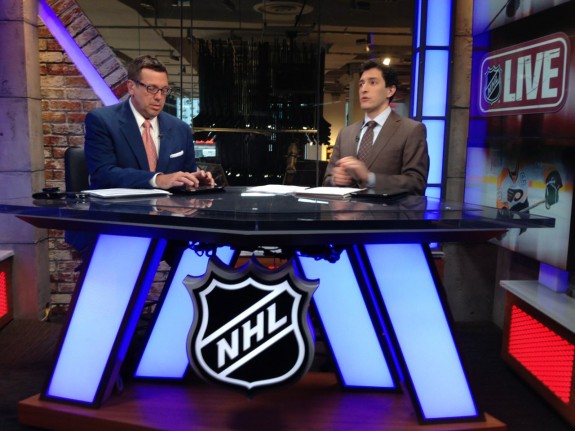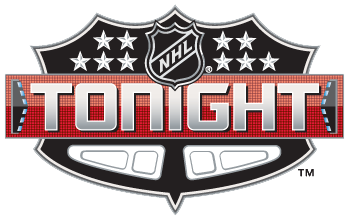
When the NHL Network launched in Canada in 2001, the thought of having 24/7 NHL news, programming and games was enough to make any hockey fan drool. It was a network that gave fans a dedicated channel to tune in to for their 24/7 hockey fix without having to wait for a pre- or postgame show or scour the Internet for the latest news and happenings.
The success of it in Canada resulted in the launch of the network in the United States on October 1, 2007, which then brought the thought to many that the league-run network was set to soar to the heights of the NFL Network and NBA TV.
But although the NHL has this remarkable tool at its fingertips, the network has stalled out over the years as the league has yet to find out how to fully utilize the channel in the capacity that their successful counterparts have. In fact, you could say that the quality of programming and production on the NHL Network rivals what you would find on public access television at two-thirty in the morning.
The live games are nice, but that’s programming that is to be expected on a league network. NHL Live and their two main nightly highlight shows, NHL Tonight and NHL on the Fly, also provide good chunks of programming, but those only make up a few hours of the day. They also are shows that don’t air much, if at all, during the offseason. And when those programs aren’t airing, which is a large portion of the time, fans get treated to vintage games, old top ten lists and countless reruns of recent playoff games. It’s a nice programming set, but when that’s all you get, it gets really old, really fast.

But programming, despite its major flaws that will be addressed more on later, isn’t the only problem with the NHL Network. The production value of the live shows just aren’t as good as what you’d want from any channel, let alone a league-run network. The hosts of the nightly shows, Mark Roe and Andi Petrillo, do an admirable job given the circumstances, but it’s just not enough to carry the awful “analysis” viewers are subject to during the shows.
Each and every night, aside from a few personalities, fans are given stuttering, stumbling and cliche breakdowns that sound like they’re being given by a college student sitting in front of the camera for the very first time rather than people employed by TSN. You can tell that not much time, if any, went into preparing the long list of former pro players for their time behind the desk, and that’s a real shame. Just some sort of on-screen training can go a long way towards making shows more genuine.
But never fear hockey fans, the NHL Network can be fixed. A lot needs to be done, but it’s not impossible to imagine a time in the near future where the league’s network can be taken as a serious choice for fans throughout the year.
Let’s start with the big elephant in the room: money. For a network to be a success, money has to be put into in the form of talent, production and aesthetics, among other details. From speaking with former employees of the network, both on-air and behind the scenes, the vibe from all of them was that the NHL Network was viewed, and treated, like it was no more than a side project just so the league can say it has a network. It never has been put in a position to succeed due to those in charge not viewing it as a vital part of the league’s broadcast package.
Recent News/Commentary Posts:
[catlist categorypage=yes numberposts=3 excludeposts=this]
Pay for on-screen talent training, improve the general look of the show sets and hire some better visual and graphic designers as a start. Should quality time and money be invested into the station, then there is a great chance for a turnaround in its fortunes. With that being said, no network is successful without quality programming.
As stated above, the current shows are a good building block, but much more can be done. Now, the easiest route to take would be adding even more live games to the network in the form of NCAA, Major Junior and International Hockey, but you can only add so much. Still, the more the merrier when it comes to games, which has gotten better over the years. But what about times during the day when games aren’t on? How about the offseason, when all we get are the previous year’s playoff games that no one, aside from fans of the Stanley Cup-winning team, really want to relive?
What would fans like to see other than the traditional shows that you can get on any channel? Shows that take fans on full tours of the various arenas around the league, give a look inside the life of a new player each week or even something that resembles a hot stove-like talk show that fans can watch a few hours each day, whether it be in the morning or afternoon. All of those offer an opportunity to build the audience and the NHL Network brand.
What about when major news breaks? Often times, no matter the story, if a a fan tunes in to the network to find out what’s going on, they won’t learn anything at all. Instead, fans will continue to watch that all-so-important 1974 game between Boston and Philadelphia. Break away for a story, or press conference. When fans want to know what’s going on with your league, it’s probably best to make sure they can tune in and get it.
There is a long way to go before the NHL Network can even be considered as a legitimate sports network. However, by doing some actual work on improving the general content and overall quality of said content, it could become a top-tier network for hockey fans everywhere.